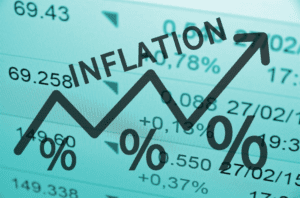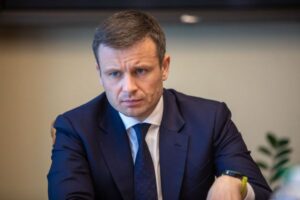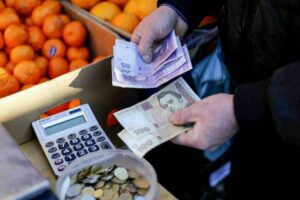
The year-over-year growth of consumer prices in Ukraine in September 2021 accelerated to 11% from 10.2% in August, the State Statistics Service reported on Friday.
According to the service, after deflation of 0.2% in August, inflation was recorded at 1.2% in September this year, while in September last year, inflation was 0.5%.
In addition, the State Statistics Service last month recorded underlying inflation at 1.3% after zero underlying inflation in August 2021. In September last year, underlying inflation was 1.1%.
In the consumer market in September, prices for food and non-alcoholic beverages grew by 1.1%. Most of all (by 13.6%) eggs have risen in price. Prices for lard, vegetables, milk and dairy products, meat and meat products, butter and bread rose by 3.7-1.1%. At the same time, fruits, sunflower oil and sugar fell in price by 3.4-0.1%.
Prices for alcoholic beverages and tobacco products grew by 0.8%, which is associated with a rise in prices for tobacco products by 1.1%.
Clothes and footwear went up in price by 7.9%, including footwear – by 8.2%, clothes – by 7.6%.
The rise in prices (tariffs) for housing, water, electricity, gas and other fuels by 0.5% was mainly due to an increase in prices for natural gas by 1.8%, maintenance and repair of housing – by 1.4%, and housing rent – by 0.9%.
Transport prices decreased 0.1% due to a decrease in the cost of travel in railway passenger transport by 1.7%, fuel and oils – by 0.2%.
Education services have risen in price by 13.2%, namely: high education – by 17.3%, medium education – by 11.5%.
As reported, in August and July consumer prices rose by 10.2%, in June – by 0.2%, in May – by 1.3%.
In January-August 2021, inflation in Ukraine amounted to 7.5%, and underlying inflation was 5.5%.
The National Bank of Ukraine forecasted inflation in September-October at the level of 10-11% with a further decline below 10%.

Finance Minister Serhiy Marchenko sees the potential to keep inflation within 10%.
“There are hopes that it will be possible to keep inflation within 10%, not exceeding 10%,” he said during the Ukrainian Financial Forum, organized by ICU.
According to the State Statistics Service, inflation in July 2021 in Ukraine increased to 10.2% in annual terms, while in June this figure was at the level of 9.5%. At the same time, the NBU expects that by the end of the third quarter, inflation will peak this year at 11.2%.
Commenting on deteriorating expectations of a number of investment banks regarding the growth of the Ukrainian economy, the minister noted that these forecasts are based on GDP growth in the second quarter compared to the same period last year.
“It is still difficult to estimate the end of the year, because main capital investments and expenditures are planned for the third or fourth quarter,” Marchenko said.
According to him, the situation will improve, as evidenced by the constant growth of retail turnover, as well as the growth potential of the construction industry.
“By the end of the year, we expect a stable situation both in public finances and in the economy, without sharp shocks. I think that we will have 4% of GDP growth this year,” Marchenko said.
FINANCE MINISTER, INFLATION, SERHIY MARCHENKO, UKRAINE'S INFLATION

The National Bank of Ukraine (NBU) expects inflation to rise to 11% in 2021, according to a chart released by the central bank.
According to the forecast of the rate curve, the regulator expects inflation to slow down with a return to the 5% target in the second half of 2022.
It is indicated that with a probability of 30%, the inflation rate by the second half of 2022 will be in the range of 4-7.5%.

The National Bank of Ukraine (NBU) has revised its 2021 inflation forecast from 8% (in its April forecast) to 9.6%, and expects that inflation will return to 5% in H2 2022.
“With global prices surging and demand recovering further, the NBU has revised its 2021 inflation forecast from 8% to 9.6%. After peaking in the fall of this year, inflation will begin to slow as the new harvest arrives and global energy prices adjust… inflation in H2 2022 will decline to its 5% target and remain there going forward,” the NBU said on its website on Thursday.
Inflation will soon rise to slightly above 10%, but it will weaken at the end of 2021 and return to its 5% ± 1 pp target range in H2 2022.
The rise in inflationary pressure, including its fundamental component, is also driven by the dynamic recovery of the economy, as evidenced by monthly and other high-frequency indicators. By tightening its monetary policy, in particular through raising its key policy rate and rolling back its emergency monetary measures, the NBU will also keep inflation expectations under control and gradually reduce underlying inflationary pressures.

The growth of consumer prices in Ukraine at the end of June 2021 decreased to 0.2% from 1.3% at the end of May. In annual terms, inflation remained at 9.5%.
The State Statistics Service said on Friday, that core inflation in June was 0.4%, while in May it was at 0.7%.
In general, for the first six months of 2021, inflation in Ukraine amounted to 6.4%, core inflation to 4.3%.

The National Bank of Ukraine (NBU) has revised its inflation forecast from 7% to 8% in 2021, expecting inflation to return to the 5% target in H1 2022.
“Considering the fast-paced recovery of the global economy and higherinflationary pressures, the NBU revised its inflation forecast from 7% to 8% in 2021, expecting inflation to return to the 5% target in H1 2022 and settle at this level further on,” the NBU said on its website on Thursday.
The central bank said that inflation will peak in Q3 2021. Inflation will start to decelerate in autumn, return to the 5% ± 1 pp target range in H1 2022, and subsequently remain there.
The steep rise in inflation was largely driven by temporary factors, such as growing global prices for food and energy. A revival in the global economy and the effects of smaller harvests continued to push up prices. A low comparison base also played an important role.
Underlyinginflationary pressures increased due to sustained growth in consumer demand, which was, among other things, fueled by higher wages, the NBU said.
Retail turnovers consistently exceeded pre-crisis levels, being 5.6% year-over-year larger in February, the central bank said.